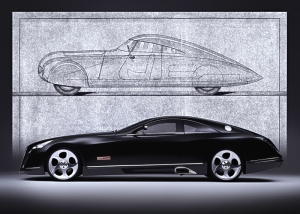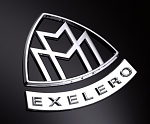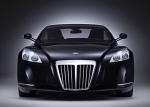
.
. .
..
. . .
Models:
© 1999-2004
Copyright |
Maybach Exelero Concept
An indispensable helper in the boat with the project partners: two professors and four students from Pforzheim Polytechnic’s Dpartment of Transport Design. Together with the design professionals from DaimlerChrysler, under the direction of Professor Harald Leschke, the team went to work and after three-quarters of a year of promising design proposals, it was decided to realize the outline of the student Fredrik Burchhardt. He succeded in producing the most elegant symbiosis of design elements of former and present vehicle generations. The model phase starts Three model construction phases in the manufacture of a special vehicle are decisive in the development process:
Based on detailed and strict time schedules, all three phases were realized simultaneously. The well-known Italian vehicle study manufacturer Stola in Turin was commissioned by DaimlerChrysler to build the Exelero. The sports coupé was also now given its final project name: Maybach Exelero. On 31 May 2005 everything was ready. All three phases were completed. The 1:1 model for the exterior had been tested in the wind tunnel many times, modified and adapted. The interior details were fixed: natural leather, neoprene, coated punched aluminum sheet as well as carbon fiber in glossy black and red are the main materials. And the technicians who worked on the vehicle had arranged, rebuilt and made ready for use all the functions and the parts needed for this. Dipl.-Ing. Jürgen Weissinger, the responsible project technician and development manager at Maybach, connected the battery, turned the ignition key and the car growled into life. The short burst of gas suggested record speeds. The construction and test phase concluded with a outstanding success Transforming a limousine, the basis for the Exelero is the Maybach 57, into a coupé is extremely demanding. Jürgen Weissinger and his team were astonished to find that, although the dimensions of the former SW 38 differed in the length (the Maybach 57 has a 290 millimeters longer wheelbase), in terms of breadth and height they were very similar. That simplified a whole series of structural measures. When considering the engine alternatives, it soon became clear that the basic twelve-cylinder engine used in the Maybach limousines would not achieve the desired maximum speed of around 350 km/h despite the Biturbo turbo charger. Here, the Mercedes Car Group leapt into the breach. The engine specialists in Untertürkheim, the place where all basic engines are developed, provided energetic support for the project. After several optimization of the Maybach type 12 engine, the cubic capacity was increased from 5.6 to 5.9 liters and the turbo charge optimized. The result was convincing: on the test bed almost 700 hp and at least 1,000 newton meters of torque were recorded, sufficient to achieve the targeted maximum speed of 350 km/h. Before, during and after the aforementioned work, the individual evolutionary steps were supported by corresponding tests. Either on engine test beds in the plants or on test tracks like the high-speed oval in Nardo/Southern Italy or the test track in Cloppenburg. The final test measurements at the end of April/beginning of May 2005, once again on the high speed Motodrom Nardo, then produced the well-earned success of lost of hard work: a top speed of 351,45 km/h - a world record for limousines – on standard tires. And yet another world record: between the Fulda idea, the outstanding cooperation of all concerned and the delivery of the Maybach Exelero sports coupé, just 25 months passed. Thanks to all cooperation partners Yet again in Fulda Reifen’s company history, a cooperation has led to an exceptional final result: a top-class product like the Exelero ultra-high performance tire is matched by an exceptional vehicle, unmatched anywhere else in the world, the Maybach Exelero sports coupé. The result can never be the product of just one individual, only within the framework of a partnership at the highest level and the uncompromising efforts of all concerned can such a project succeed. The Fulda project team under the direction of Bernd J. Hoffmann, Chairman of the Board of Management, would hereby like to thank everyone involved, particularly the responsible persons at
May 18, 2005 photos: Maybach
|
.
|






















